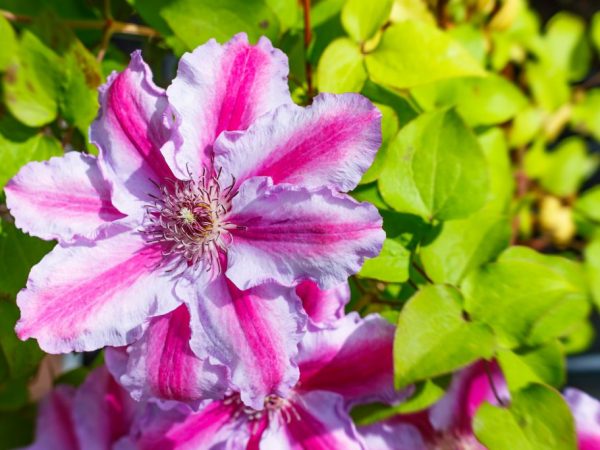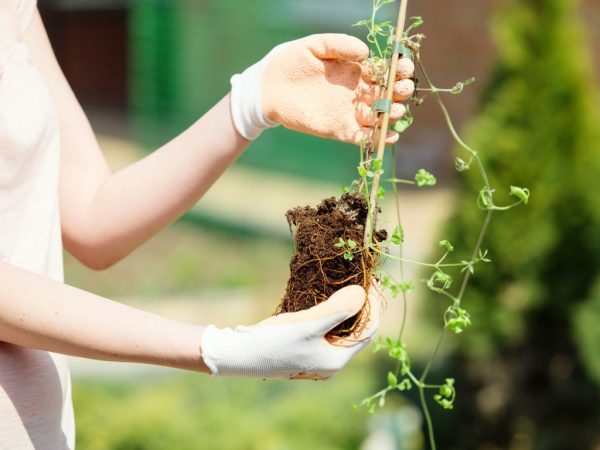Planting clematis in the fall in open ground
Clematis are beautiful flowers that are planted to decorate the site. In order for the bush to be strong and delight with flowering for a long time, good care is needed for it: watering, feeding, preventing diseases. Also important is the correct planting of clematis in the fall in open ground.

Planting clematis in the fall in open ground
Choosing a landing site
It is not difficult to plant clematis correctly in the fall. This plant can grow in one hole for up to 25 years. It is picky, it does not need to be fed often, but certain conditions are necessary for it to grow properly. In warm regions, you should not plant clematis near a metal fence and walls of buildings. This will help prevent water from getting on the flower. It is better to plant clematis in the fall not with seeds, but with a young seedling.
Planting clematis seedlings outdoors in the fall is easy. The place should be well lit by the sun; for proper development, the bush should be under the rays for at least 5-6 hours a day. But there are some exceptions. These include the princes. They have large flowers and bloom 2-3 times a year. They are not afraid of cold and lack of light.
You can not plant clematis in the fall in a draft, because brittle clematis flowers will break in the wind. It is unpretentious to the composition of the soil, but you should not plant it in an acidic environment, the pH should be at the level of 6-6.5, and the height of the groundwater should not exceed 135 cm. Also, wetlands are not suitable for growing clematis.
For the winter, the branches are removed from the trellises and covered so that they do not freeze and the bush does not die. Sometimes this is difficult to do because the bush grows a lot.
Rules for growing clematis in the fall:
- Not all types of this plant are suitable for growing near supports. It is worth stopping the choice on those varieties that need pruning.
- You cannot plant this bush near houses. Water that flows from the roof will cause waterlogging of the soil, the plant will die.
- These flowers need space, so the distance between the bushes should be at least 1-2 m.
Drop off time
The timing of planting seedlings depends on weather conditions and climate. In warmer areas, clematis is planted in autumn, in September or October. If the winter is not very harsh, the bush will have time to take root well and in a year will delight with abundant flowering.
In colder climates, planting is carried out in the spring or late summer in August. It is worth preparing for the fact that in the first year the shoots will be weak, and the growth of the branches will be slow. Clematis will bloom regularly only 2-3 years after planting. Planting clematis in the fall is more beneficial.
You can plant clematis in the fall and spring. Best timing: early September - late October. If you plant a seedling later, rooting will go badly, in winter the bush may die.
Well preparation
To plant clematis in the fall, a large hole is required. Its depth should be at least 65-75 cm. Before planting, drainage is poured on the bottom of the hole, the layer thickness of which should be at least 15 cm.
To plant clematis in the fall, it is necessary to prepare drainage, for this they use:
- pebbles;
- broken brick;
- crushed stone.

Landing site must be carefully prepared
Planting clematis in the fall provides that the bottom is filled with fertilizer from peat, turf, sand and humus. They also take ash and mineral fertilizer in equal amounts. It is useful to add 175 g of dolomite in powder form to these.
To sprinkle a clematis seedling, you should not use the soil that was taken when digging a hole. It is worth buying a special vitamin mixture or preparing it yourself, and then planting a seedling in it.
Planting clematis
Planting clematis in the ground in the fall requires digging a deep hole so that the young bush does not die. Several lower buds and the root collar should be below ground level. This is necessary so that the flower begins to bush faster and the root develops correctly.
Rules for planting autumn clematis:
- a seedling with a small clod of earth is lowered into a hole;
- sprinkle first with sand, and then with soil and nutrient mixture;
- the lower shoot and the neck are covered with a mixture of ash and sand;
- the aerial part of the stem is cut off so that no more than three buds remain.
After planting, the clematis seedling is watered abundantly. In the spring, the active growth of the bush will begin, but it will bloom only in a year. During this period, a small amount of top dressing of clematis is introduced. Clematis quickly takes root in a new place in the fall.
Seedling care
After the autumn planting of clematis, he needs good care. the soil around the stem should be regularly loosened and watered. Young clematis in the fall receives a sufficient amount of fertilizers, if they were applied during planting. Additional feeding of clematis in the fall is not needed, because it can cause root rot.
To feed clematis in the fall, it is enough to add a small amount of copper sulfate. It is also useful to plant low ornamental plants near it, they will protect the young bush from the sun.
Conclusion
Correct planting of clematis in the fall is especially important for the development of the plant. It is picky to care for, for many years it grows in the same place and is distinguished by abundant flowering.
Planting clematis in the open ground in autumn is not difficult, they do not require additional feeding. In order for the bush to decorate the site for a long time, it is important to follow certain rules. It is better to plant young seedlings in early autumn, then they will get stronger by winter and will bloom next year. Planting clematis in autumn is more desirable. Disembarkation in September or October is best suited.


